Downy mildew is the most common infection of spring crops. These infections are characterized by leaf spots, distortions, and blights. Sometimes, the disease and symptom development on host plants are too late by the time (diagnosis of downy mildew is difficult). Then, the only solution is to pull out the plants and discard them completely. Therefore, in the case of downy mildews, the best practice is prevention.
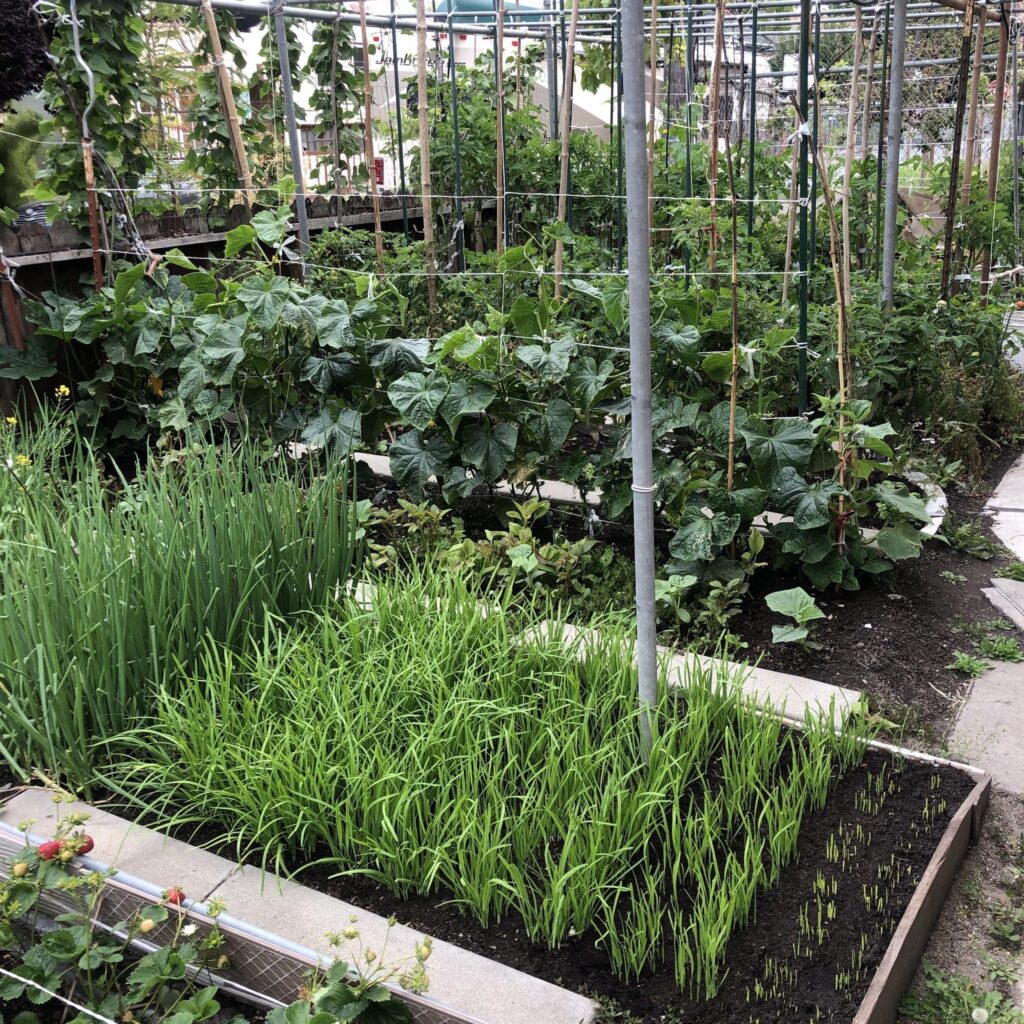
A healthy vegetable garden looks so refreshing to the eyes
This article will discuss the step-by-step guide to downy mildew disease identification and its control by organic means without relying on toxic chemicals. It will also provide information about the conditions in which these infections grow on plants. Therefore, by interfering with these conditions, you’ll be better able to control downy mildew.
What is Downy Mildew?
Downy mildews are many plant pathogens that majorly cause foliar diseases. These are obligate pathogens that can not live without their host plants. They are closely related to oomycetes or water molds.
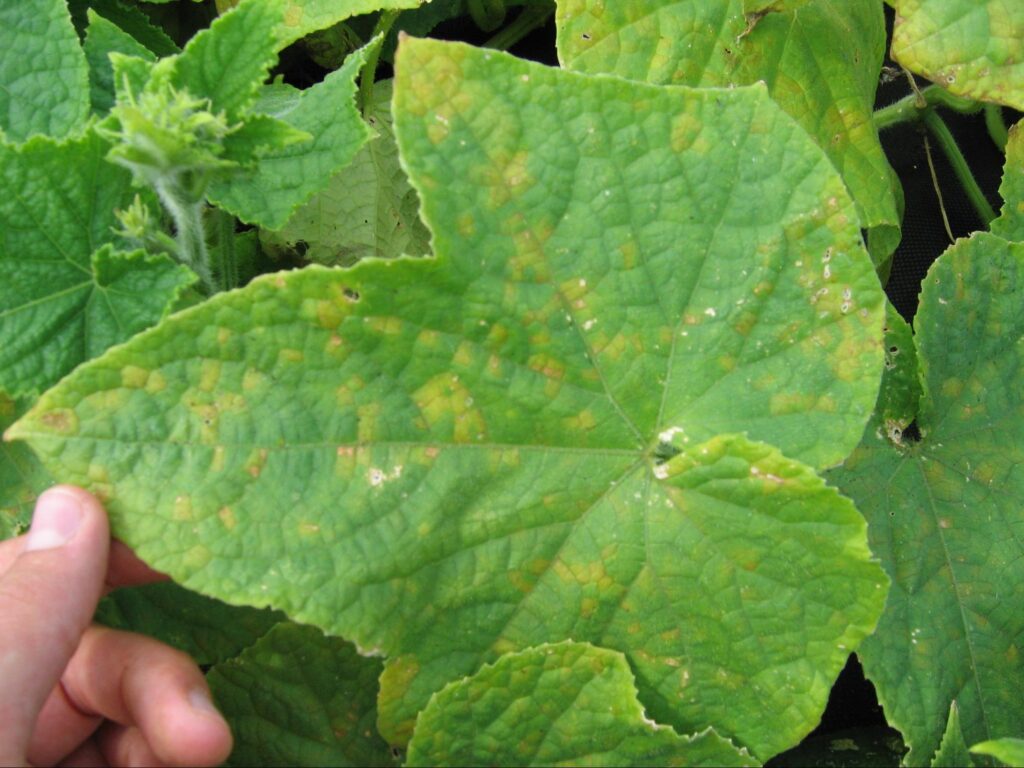
Downy mildew damage on cucurbits, and the leaves have pale yellow spots with white spore fuzz on the underside
The downy mildew pathogen that infects most crops belongs to either the genus Plasmopara or Peronospora. Such as the host plants include greenhouse crops, landscapes, herbaceous plants, and nursery plants.
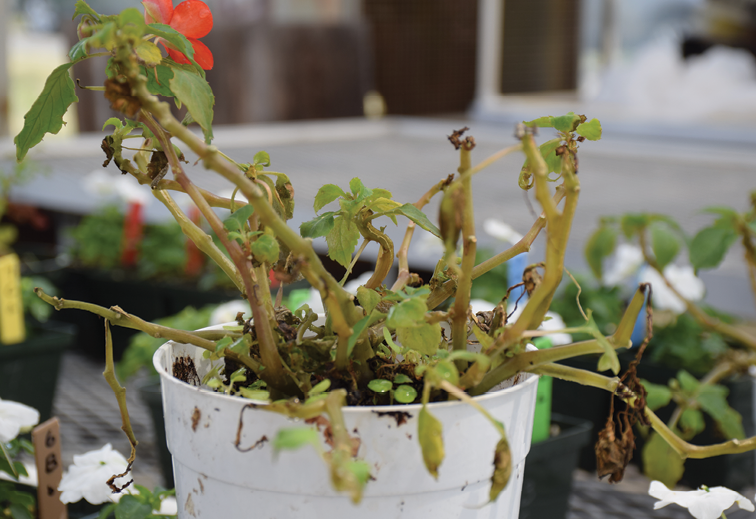
Impatiens plant heavily infected with down mildew pathogen
These pathogens have a broad host range or narrow. Such as the downy mildew that infects impatiens (touch me, not plant) will only damage impatiens—it is an example of a limited host range.
On the other hand, the downy mildew that infects sunflowers will also infect the members of the daisy family—an example of a broad host range.
Note: Gardeners often confuse downy mildew with powdery mildew, another most common and destructive disease of garden vegetables. However, the important thing is both (downy and powdery mildew) are different diseases caused by various pathogens and require different levels of treatment.
Downy mildew spreads through airborne spores from plant to plant. The infections are more severe during cool temperatures with abundant moisture content on the leaf surface.
Essential Characteristics of Downy Mildew
| Common name | Downy mildew |
| Causal agent | Oomycetes or water molds |
| Host plants | Ornamental plants, impatiens, daisies, pansies Edible crops such as onions, grapevines, sweet basil, lettuce, and the members of the Brassicaceae family |
| Scientific name | Peronospora spp, Palmospora spp, and Bremia |
| Disease distribution | Worldwide |
| Disease development | Cool temperatures with high humidity (spring, summer, and autumn) |
| Characteristic symptoms | White or grey color mold on the underside of infected leaves |
Is Downy Mildew Harmful?
Downy mildew is an umbrella term for many plant diseases and is essential in plant pathology due to its close relevance to Phytophthora spp. Yes, it is harmful to plants and indirectly to humans because its infections result in yield losses or crop failure.
Downy mildews are obligatory pathogens that can only complete their life cycle on a specialized host plant. They develop and reproduce quickly and cause havoc on vegetable gardens by killing the whole crops within a week.
What are the Downy Mildew Symptoms on Host Plants?
Downy mildew is a foliar disease, and disease infection and progression starts from leaf tissue (lower and upper surface).
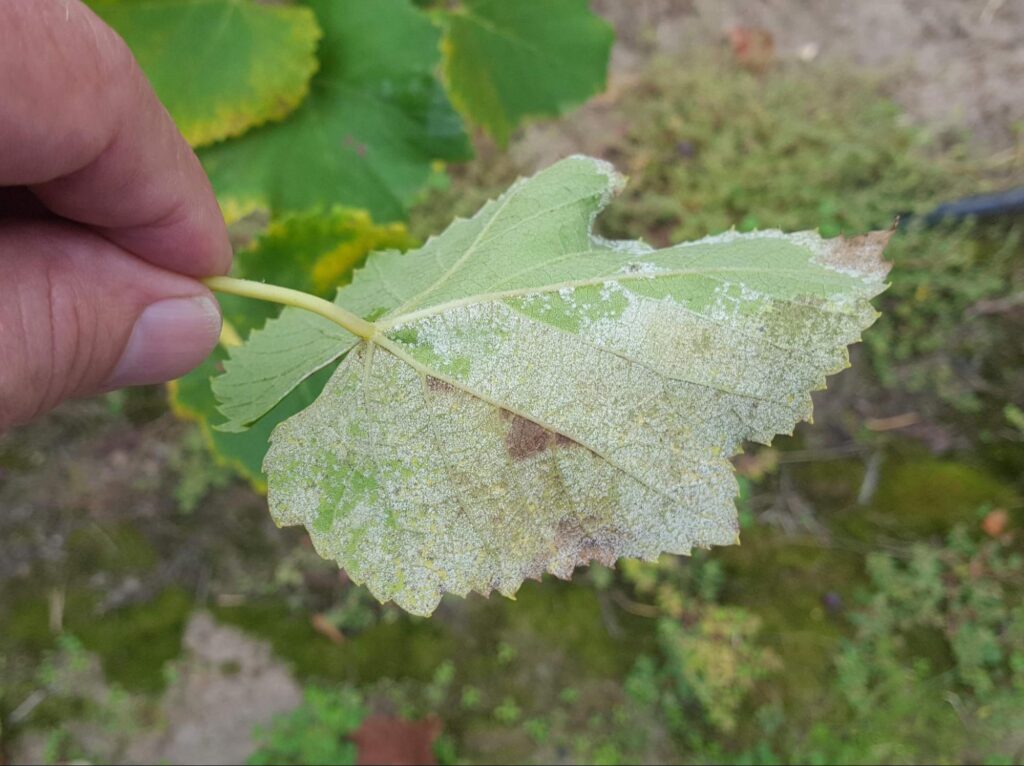
White color fuzz or spore formation on the underside of the grape leaves
One of the characteristic symptoms of downy mildew infection is the development of mold-like growth on the bottom leads to discolorations on the upper surface of leaves. Such as the given below image:
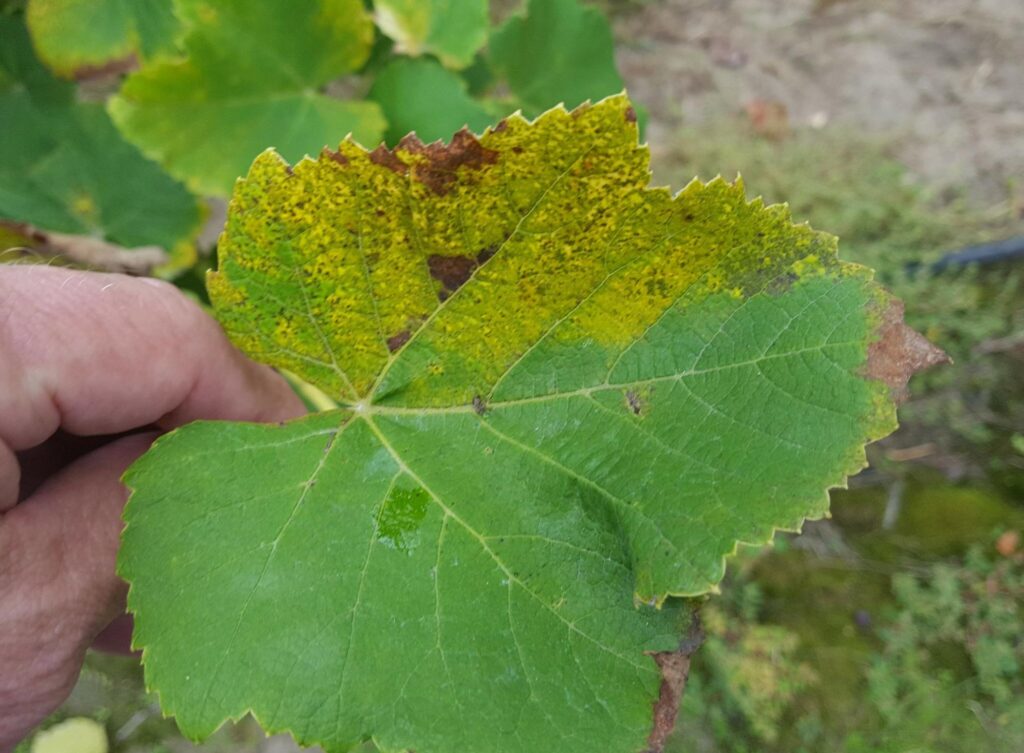
Yellow-colored patches on the upper surface of the leaf due to sporulation below
Pale color spots appear on the upper surface of leaves. As the infection progress, these spots turn brown. Under severe infections, these yellow blotches merge and turn brown due to dead cells.
The severely infected leaves become brown and shrivel and may fall to the ground.
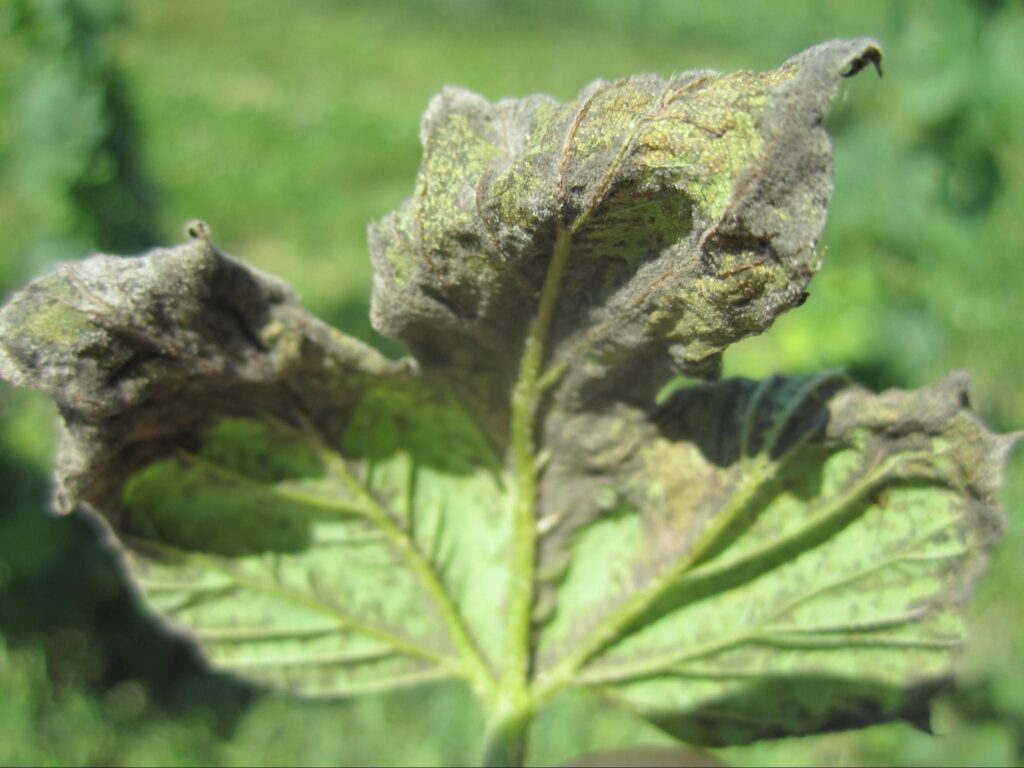
Discoloration, wilting, and distortion of a badly infected host plant leaf while spore production on below
During favorable weather, the downy mildew pathogen develops rapidly, and it becomes difficult for growers to recognize and control downy mildew, unlike powdery mildew (easy to diagnose at early stages).
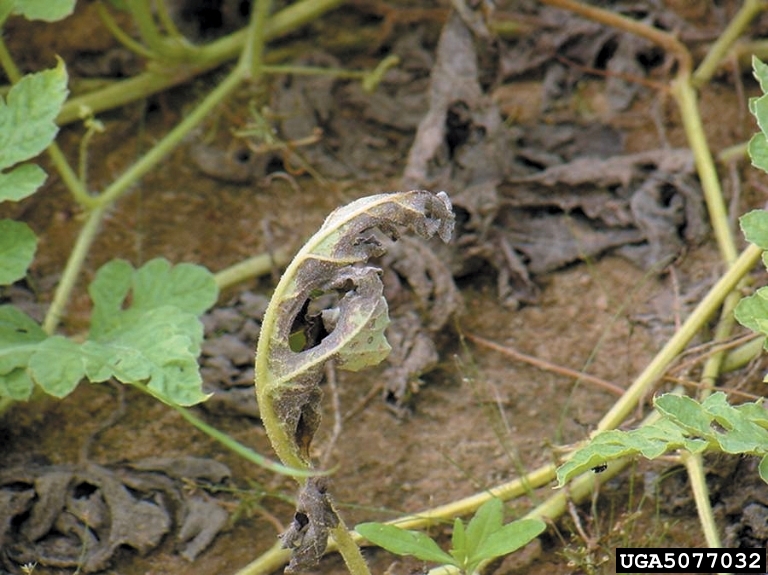
Downy mildew on watermelon leads to complete failure of the crop
Life Cycle of Downy Mildew
The life cycle of downy mildew is complex. They need living hosts to complete their growth and reproduction. The downy mildew disease overwinters in dead plant debris such as mycelium or oospores.
The oospores germinate when the environmental temperatures are 50 to 75 with 85% or above humidity levels. These germinating oospores produce sporangiophores which host wind and waterborne zoospores. These zoospores burst out of the leaf stomata of infected plants and travel to neighboring healthy plants through wind and water.
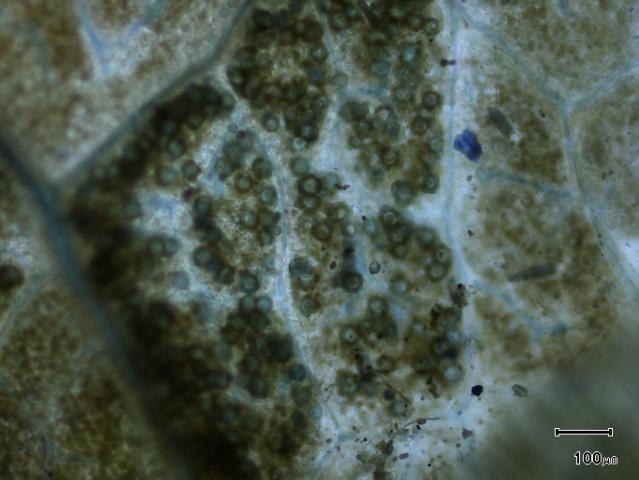
Overwintering downy mildew as oospores on a grapevine leaf Photo Credit
This cycle takes only 7 to 10 days. However, when the weather conditions are ideal (wet leaf surfaces with cool temperature), it only completes within four days and infects the entire crop. The disease development is so rapid that growers cannot diagnose the disease and apply control methods to prevent downy mildew.
Downy mildew is caused by fungus-like organisms that need an extended period of moisture for infection in the growing season. Therefore, severe outbreaks of downy mildew disease occur in outdoor environments, most commonly when the temperature is low during the night.
On the other hand, in greenhouses, the fungus-like organisms remain throughout the year and are more destructive during spring and autumn.
Downy Mildew Control—Organic and Chemical Methods
Controlling downy mildew through toxic chemicals is not a wise option because of the rate at which downy mildew disease develops; it is impossible for growers to early diagnose and control them. So, the only best choice is prevention against downy mildews. These all methods come in the category of organic control.
Following is the list of best approaches to prevent downy mildew:
Use Resistant Varieties
- One of the best management strategies is planting downy mildew-resistant varieties. Resistant cultivars will not allow the oospore (overwintering spores) germination and block the pathogen at its early stages.
- Make sure not to get the contaminated seeds from nurseries.
Air Circulation
- Wet leaf surfaces provide the perfect conditions for downy mildews to invade plants. So, eliminate moisture to discourage spore germination through timely pruning.
- Pruning will improve air circulation and inhibit pathogen growth and multiplication.
- Ensure proper space between row crops and plants for proper air circulation even after they mature.
Monitoring of Plants for Downy Mildew
- Regularly monitor plants for downy mildew infection.
- If you find any plant with symptoms, remove that plant and discard it in the trash.
- Moreover, do not put these symptomatic plants in the compost pile because the home compost does not have enough temperature to kill the pathogen and its spores.
Use Drip Irrigation to Control Downy Mildew
- Avoid overhead irrigation of vegetables and houseplants.
- Do not water the plants from the top because most plant pathogens and pests require wet foliage to germinate.
- If you want to water the plants from the top, apply in the early morning hours. So, the plants have enough time for sun exposure and drying.
- One of the best and most effective solutions is to use a drip irrigation system to water your vegetable garden. This method is also practical because it saves money and water.
Mulching to Prevent Downy Mildew

Organic mulching prevents soil moisture, nutrients, and dead plant leaves
- Mulching prevents soil moisture loss and leaves no place for downy, mildew-infected leaves.
- Mulch keeps plant roots warm in winter and cool during summer. Therefore, three inches of organic mulch near garden plants save the cost of other chemicals to keep the downy mildew away.
Eliminate Overwintering Sites
- Sanitation is key to preventing microbial infections and insect pest infestations. Removing these leaves will prevent crops from disease because the spores of downy mildew overwinter in plant debris.
- In the case of ornamentals, the best solution is the selective pruning of plants for good air movement.
- Keep the leaf surfaces dry because moisture levels support the infection.
FAQs
Which Fungicide is Best for Downy Mildew?
Copper-based fungicides are often used to control downy mildew. However, the copper-based fungicides are not for the long term because they may build up in the soil and can kill the soil’s beneficial microbial community. Therefore, care must be taken while using these chemicals. This chemical also makes vegetable crops photosensitive.
The best alternative to this chemical is neem oil, which is organic and can block the germination of oospores for plants’ excellent health.
Can You Eat Leaves With Downy Mildew?
No, downy mildew damages the entire leaf, and the foliage turns brown and shriveled under severe infections. So, the diseases of fungus-like organisms result in complete failure, and we can not consume leafy vegetables. They produce grey fuzz on the below surface of leaves (oospores) that corresponds to the upper surface yellow or brown color blotches.
Sources for Further Reading
- Planet Natural. (2022, March 9). Downy Mildew: Symptoms, Treatment and Control. Retrieved March 29, 2022, from https://www.planetnatural.com/pest-problem-solver/plant-disease/downy-mildew/
- Schuh, M. (2022). Downy mildew of cucumber, melon, and squash. UMN Extension. Retrieved March 29, 2022, from https://extension.umn.edu/disease-management/downy-mildew-cucurbits
- Moorman, G. W., Ph.D. (2022, March 15). Downy Mildew. Penn State Extension. Retrieved March 29, 2022, from https://extension.psu.edu/downy-mildew
- Downy mildew | Disease Control & Treatment | Bayer Crop Science. (n.d.). Bayer Crop Science Australia. Retrieved March 29, 2022, from https://www.crop.bayer.com.au/pests/diseases/downy-mildew
After learning about downy mildew disease, make sure to read our other articles:
Identification and Control of Rust Fungus by Natural and Chemical Ways
Why Are The Leaves Turning Yellow? 8 Reasons Why Your Pothos Is Changing Color







